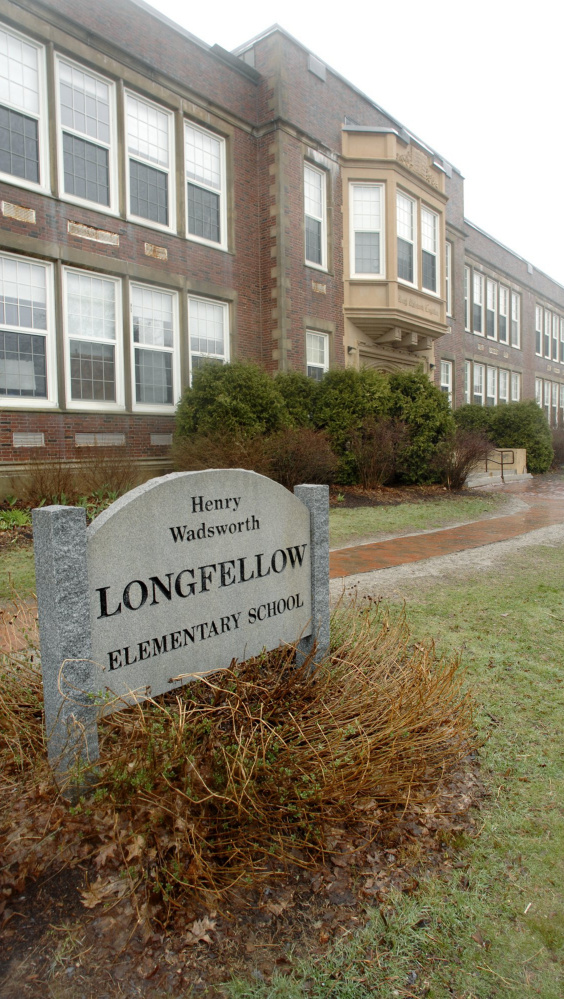Tests have come back negative for the presence of mold at Longfellow Elementary School, a concern that had become a political flash point in dueling bond issues that will ask voters on Nov. 7 whether to renovate two or four Portland elementary schools.
Parents noticed a discoloration on a hallway ceiling at Longfellow on Oct. 3, which led to the testing. It also prompted supporters of a four-school renovation to hold a news conference in front of Longfellow and point to the potential mold discovery as a reason for voters to back the $64 million plan.
The “fix two” campaign asks voters to spend $32 million to renovate Lyseth and Presumpscot while waiting to see if state funding comes through to rebuild Reiche and Longfellow.
According to an email sent to school board and city officials Tuesday by Xavier Botana, superintendent of Portland schools, the final report on Longfellow shows there was “no mold.”
“The conclusion from multiple tests ranging from visual inspections to air and shaving cultures is that there is no mold. The discoloration is a build-up of environmental dust from road traffic and ambient dust,” Botana wrote.
Mold was discovered in late September in a utility trench outside Reiche school, caused by a leaky pipe. That mold was cleaned up and the pipe was fixed, Botana said in an Oct. 12 letter to the Reiche community. The mold was not airborne, Botana said, and not a danger.
The concerns about mold at Longfellow and Reiche were publicized by proponents of renovating four schools.
Justin Alfond, a former state senator and Reiche parent who advocates for fixing two schools, said the group campaigning to fix all four schools, Protect Our Neighborhood Schools, politicized the issue.
“You clearly used this as another reason to rally your troops,” said Alfond, referring to the news conference in front of Longfellow on Oct. 11. “It definitely stirred the pot. This all could have been done behind the scenes.”
‘HUGE RELIEF’ FOR THE SCHOOL COMMUNITY
Emily Figdor, the principal officer of Protect Our Neighborhood Schools, said the group simply raised the issue and was following the lead of the school district. Botana wrote in an early October letter to the school community that the ceiling discoloration at Longfellow was “likely mold.” An Oct. 7 post on the four-school proponents’ Facebook page showed the dark, discolored spot on the Longfellow ceiling with the word “gross” placed over the photos.
Figdor said the group never claimed it was definitely mold, it was just looking out for the health and safety of students and staff.
“We’re very grateful the district took this issue seriously,” Figdor said. “It’s a huge relief for the Longfellow community.”
After Botana notified Reiche parents about the mold at that school, Figdor had told the Portland Press Herald that “enough is enough: No more mold, asbestos, hazmat suits or caution signs in our schools.”
Alfond, who heads the Better Schools, Better Deal campaign, said that regardless of political motivations, the Longfellow news is “great news for kids, the community and teachers.”
Mayor Ethan Strimling, who supports renovating four schools, said the administration handled the issue responsibly.
“I don’t think it was overblown,” Strimling said. “A concern over mold is something that should be taken very seriously.”
Botana said in an interview Wednesday that small ceiling sections in two areas of Longfellow were tested.
“It wasn’t widespread,” Botana said. “The spots were very localized.”
MOLD NOT NECESSARILY A HEALTH RISK
The presence of mold in a building does not necessarily mean that it poses a health risk, according to the U.S. Centers for Disease Control and Prevention. “Exposure to damp and moldy environments may cause a variety of health effects, or none at all,” the CDC website says. “There is always a little mold everywhere – in the air and on many surfaces.”
The quantity of mold and how widespread it is in a building, for instance, factor into whether mold poses a health hazard. Also, people are affected in varying ways by mold exposure and react in different ways to different types of mold, with the most common reaction being allergies.
“For these people, molds can cause nasal stuffiness, throat irritation, coughing or wheezing, eye irritation, or, in some cases, skin irritation,” according to the CDC. Molds also can exacerbate asthma symptoms.
Residents may vote yes or no on either of the elementary school bond questions. If both receive a majority, the referendum with the most votes will be enacted.
Joe Lawlor can be contacted at 791-6376 or at:
jlawlor@pressherald.com Twitter: joelawlorph
Copy the Story LinkSend questions/comments to the editors.




Success. Please wait for the page to reload. If the page does not reload within 5 seconds, please refresh the page.
Enter your email and password to access comments.
Hi, to comment on stories you must . This profile is in addition to your subscription and website login.
Already have a commenting profile? .
Invalid username/password.
Please check your email to confirm and complete your registration.
Only subscribers are eligible to post comments. Please subscribe or login first for digital access. Here’s why.
Use the form below to reset your password. When you've submitted your account email, we will send an email with a reset code.